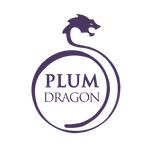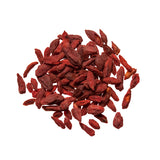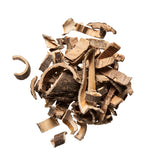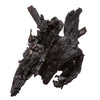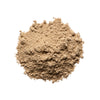How to Avoid and Relieve Delayed-Onset Muscle Soreness (DOMS)
If your training was effective, you should feel some soreness the next day, and for two days at the most. If the second day is significantly worse than the first, and your soreness lasts into a 3rd day or beyond, you have likely have what is call delayed-onset muscle soreness (DOMS), and it’s a sign that you trained too hard for your current set point.
You want to avoid excessive delayed-onset muscle soreness or DOMS whenever you can. You may think pushing yourself to the absolute max will get you to your goal faster, but unnecessary inflammation will set you back. Not only does it waste your time, but it negatively affects your energy level, your mobility level, and even your hormones and immune system. And, there’s really no upside. You don’t get any increased benefits from it that you wouldn’t have gotten from the right amount of microtrauma.
What is DOMS?
It used to be thought that this muscle pain was from trapped lactic acid–that’s the stuff that gives you that sharp burning sensation while you’re training. Even though that’s been disproved, you still hear a lot of people spouting this.
Scientists have determined that DOMS is actually from inflammation[1]. It’s your body’s token response to damaged tissue. To understand how this process works, think about what happens if you cut your skin. There’s some immediate pain, followed by a dull lingering pain. But then, as inflammation sets in, things change. It swells up a little and gets more sensitive if you press on it or stretch it. This happens because your body releases special proteins called prostaglandins as part of its response to damage, and these proteins increase your pain sensitivity and trigger the buildup of fluid around the injury.
The same sort of thing is going on in your muscles with DOMS. And if your training involves impact resistance, such as punching or kicking heavy bags, iron palm training, or anything else that applies a strong impact velocity to your body, then you will also be accruing micro-trauma in connective tissue and bone, which can still trigger its own kind of inflammatory response and usually takes even longer to heal.
Because DOMS is such a common thing, we’re going to take a comprehensive, 3 tiered approach learn how to avoid delayed-onset muscle soreness:
- Activities that Heal
- Topical Formulas that Heal
- Nutritional and Supplemental Formulas that Heal
4 Ways To Recover from DOMS Faster
Light Resistance Exercise
Believe it or not, doing extremely light resistance training at a very low intensity is the best known strategy for temporarily relieving muscle pain and for accelerating recovery by increasing blood flow to the damaged muscle and helping soft tissue to remodel more effectively.[2]

You don’t have to worry about overtraining as long as you ensure that your intensity level is light. The only goal is increased blood flow and a little bit of tug on your soft tissues. You do not want to inflict any new damage on the muscle fibers.
So make sure you stop way shy of muscular failure, even after 20-30 reps of slow, controlled movements. You want to feel a nice pump (increased blood flow) but not a massive burn (the fire you feel when lactic acid and hydrogen ions accumulate in working muscles.)
You’ll notice immediate pain relief after a single set of this. And, once your muscle is warmed up, it’s the perfect time to increase the healing stimulus with some static stretching.
Static Stretching After Light Resistance Helps Alleviate DOMS Quickly
Some people aren’t aware of this, but it’s not that beneficial to stretch cold muscles. Your muscles and joints aren’t prepared to receive the benefits that stretching has to offer unless they’re warmed up first.
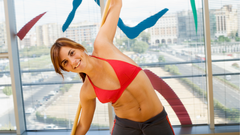
So if you do light resistance exercise as a means of decreasing your DOMS, you can get some increased benefits from static stretching immediately after it. As we learned in a previous article, static stretching improves the remodeling process by resetting tight and clumped muscles to their appropriate length, preventing adhesions from forming, wringing out metabolic byproducts, and convincing cramped, overactive muscles to relax. [3]
Contrast Hydrotherapy for Reducing DOMS Pain
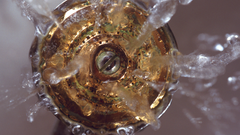
Once you’re done with that, jump in the shower and give yourself another round of contrast hydrotherapy by alternating the hot and cold. The contrast effect has definitely proven to be effective for reducing soreness and restoring muscle performance more quickly when its used the day after the workout, and any other day that a muscle is sore.[4]
Jow: Your Secret Weapon for Maximal Recovery from DOMS
No matter what you’re training for, one of your greatest advantages will come from the regular application of the right kind of dit da jow to your stressed tissues.
Because jow formulas are applied directly to the skin with powerful healing agents that have been time-tested through the centuries, they provide a totally unique means of accelerating the healing process. Their alcohol base and their preparation methods help extract the active ingredients of each herb for optimal absorption through skin pores.
If you know you have DOMS, there are 2 Dit Da Jow formulas that will help you significantly:
- Ho Family Dit Da Jow – if you have a moderate level of DOMS, use Ho Family before and after workouts. It will enhance your conditioning and accelerate your healing and reduce your soreness.
- Bruise Juice – if your level of DOMS is extreme, use Bruise Juice. Don’t let the name fool you, it’s useful for a lot more than just bruises. It’s powerfully anti-inflammatory, and it helps reduce swelling, soreness, pain, and it heals both bruising and traumatized tissue much more quickly. Use Bruise Juice only when you experience significant muscle pain and want to recover from DOMS faster.
And remember, as with all of our Dit Da Jow formulas, if you add 3 or more of them to your cart, one of them will be free!
Get A Massage to Relieve DOMS
If you can afford a massage, get one. Massage helps keep your soft tissue from remodeling in a way that leads to adhesions and tightness, and if you already have those, it helps to reduce them. It’s also excellent for loosening and soothing muscles that are chronically overworked.
I should point out that, if the only kind of muscle damage you have is the typical microtrauma induced by slight overtraining, it has a minimal effect on speeding up your full recovery.[5],[6] But, most people have a lot more problems than just that. Most people are walking clods of adhesions and imbalances. So, since it does help prevent long term performance limiters like adhesions from cropping up, you should do it as much as you can afford to.
Nutritional Protocols to Help Avoid Delayed-Onset Muscles Soreness
Avoid NSAIDS Like Ibuprofen and Tylenol
Until recently, the only anti-DOMS recourse for athletes has been to use non-steroidal anti-inflammatory drugs (NSAIDS) like ibuprofen. Unfortunately, these over-the-counter pain killers stunt muscle growth[7] and can damage the liver.
So, if you want to swallow something without the fallout of NSAIDS, a better approach is to get yourself some sitosterols, some omega-3 fatty acids, and maybe some protease enzymes.
Sitosterols Are Anti-Inflammatory and Reduce Cortisol Levels
Sitosterols are very beneficial plant compounds that decrease IL-6, one of the primary inflammatory compounds responsible for DOMS after exercise. [8] They also reduce cortisol levels, a stress hormone that increases after exercise which devours lean tissue for energy. [9] This makes them a very effective post exercise recovery aid. No surprise then, that sitosterols happen to be active compounds in a number of the healing herbs of Traditional Chinese medicine, including:
Gou Qi Zi
He Huan Pi
Rou Cong Rong
Suo Yang
Tian Men Dong
Tu Si Zi
Xu Duan
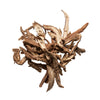
Any combination of these will help to further your recovery, along with the added benefits that each individual herb provides.
Omega 3 Fatty Acids For DOMS Recovery
Omega 3 fatty acids, like those found in fish and flax oil, are a fantastic addition to your recovery arsenal. They’re essential fatty acids – meaning your body can’t make them, so you have to eat them – found primarily in fish and wild game, and to a lesser degree in certain nuts and seeds.
They are powerfully anti-inflammatory and pro-recovery, and are protective to connective tissue, nerve tissue, and muscle tissue. One of the omega 3’s, called EPA, is so effective at preventing tissue breakdown that it’s been used effectively in cancer patients to prevent wasting.
Protease Enzymes
A study by Innerfield in 1957 showed that protease enzyme supplementation may have anti-inflammatory effects[10], and others have shown them to be specifically effective at reducing DOMS.[11] Protease enzymes include trypsin, bromelain[12], chymotrypsin and papain, and they help modulate the pro-inflammatory response by blocking pro-inflammatory prostaglandins and stimulating anti inflammatory processes. [13],[14],[15]
If you go this route, make sure you get a formula that includes that piperine. This is an ingredient extracted from pepper that increases enzyme absorption by up to 60%. [16],[17] You need this boost because enzymes don’t absorb that well in the gut[18].
In Summary
We’ve covered the different approaches to avoid and recover from DOMS in some detail, but really, it’s all fairly simple. When the DOMS sets in, start out with light resistance training for each sore muscle, and follow it up with a static stretch. When you’re all done with those, take a contrast shower and apply some Dit Da Jow immediately after. With your next meal, take your supplements: whatever combination of sitosterols, omega 3’s, and enzymes you’ve decided to use.
Follow this protocol and you’ll be back in the game with minimal downtime.
References
[2] Cheung K, Hume P, Maxwell L. Delayed onset muscle soreness: treatment strategies and performance factors. Sports Med. 2003;33(2):145-64.
[3] Sady SP, Wortman M, Blanke D. Flexibility training: ballistic, static or proprioceptive neuromuscular facilitation? Arch Phys Med Rehabil. 1982 Jun;63(6):261-3.
[4] Vaile JM, Gill ND, Blazevich AJ. The effect of contrast water therapy on symptoms of delayed onset muscle soreness. J Strength Cond Res. 2007 Aug;21(3):697-702.
[5] Tiidus PM. Manual massage and recovery of muscle function following exercise: a literature review. J Orthop Sports Phys Ther. 1997 Feb;25(2):107-12.
[6] Zainuddin Z, Newton M, Sacco P, Nosaka K. Effects of massage on delayed-onset muscle soreness, swelling, and recovery of muscle function. J Athl Train. 2005 Jul-Sep;40(3):174-80.
[7] T. A. Trappe, F. White, C. P. Lambert, D. Cesar, M. Hellerstein, and W. J. Evans. Effect of ibuprofen and acetaminophen on postexercise muscle protein synthesis. Am J Physiol Endocrinol Metab 282: E551-E556, 2002.
[8] Keller C, Steensberg A, Hansen AK, Fischer CP, Plomgaard P, Pedersen BK. Effect of exercise, training, and glycogen availability on IL-6 receptor expression in human skeletal muscle. J Appl Physiol. 2005 Dec;99(6):2075-9.
[9] Bouic PJD, Clark A, Lamprecht J, et al. The effects of b-sitosterol (BSS) and b-sitosterol glycoside (BSSG) mixture on selected immune parameters of marathon runners: inhibition of post marathon immune suppression and inflammation. Int J Sports Med 1999
[10] Innerfield I. The anti-inflammatory effect of parenterally administered proteases. Ann N Y Acad Sci. 1957 Aug 30;68(1):167-76; discussion 176-7.
[11] Miller et. Al. The effects of protease supplementation on skeletal muscle function and D.O.M.S. following downhill running. Journal of Sports Sciences 22, 365-372;2004.
[12] Taussig SJ The mechanism of the physiological action of bromelain Medical Hypotheses 1980; 6: 99-104
[13] Donaho C, Rylander C Proteolytic enzymes in athletic injuries: a double blind study of a new anti-inflammatory agent Delaware Medical Journal 1962; 34: 168-170.
[14] Cirelli MG Clinical experience with bromelains in proteolytic enzyme therapy of inflammation and edema Medical Times 1964; 92(9): 919-922.
[15] Taussig SJ, Batkin S Bromelain, the enzyme complex of pineapple and its clinical application Journal of Ethnopharmacology 1988; 22: 191-203.
[16] Atal CK, Zutshi U, Rao PG. Scientific evidence on the role of Ayurvedic herbals on bioavailability of drugs. J Ethnopharmacol. 1981 Sep;4(2):229-32.
[17] Velpandian T, Jasuja R, Bhardwaj RK, Jaiswal J, Gupta SK. Piperine in food: interference in the pharmacokinetics of phenytoin. Eur J Drug Metab Pharmacokinet. 2001 Oct-Dec;26(4):241-7.
[18] Miller et. Al. The effects of protease supplementation on skeletal muscle function and D.O.M.S. following downhill running. Journal of Sports Sciences 22, 365-372;2004.
